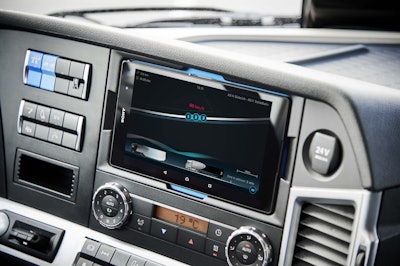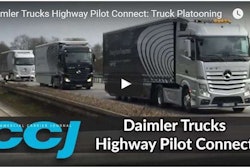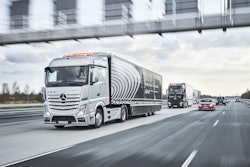 Shaping Future Transportation – Campus Connectivity
Shaping Future Transportation – Campus ConnectivityImagine a logistics supply chain where everything is connected, with the truck at the center offering permanent tracking of the driver, truck and load, along with on-demand freight matching and seamless integration at shipper and receiver facilities. The potential productivity savings are mind-boggling.
Add to that the possibilities that greater connectivity would open up to improve driver safety and quality of life on the road. For instance, the truck could sense the driver is fatigued or nearing the end of on-duty time and automatically reserve a parking spot at a rest area and reroute the driver. Vehicle-to-vehicle and vehicle-to-infrastructure connectivity could reduce highway congestion.
Of course, much of the needed technology already exists. TravelCenters of America launched its Reserve-It truck stop parking reservation system four years ago. Transponders allow PrePass users to electronically bypass weigh stations across much of the country. Real-time shipment status tracking and digital proof-of-delivery and bill-of-lading documents have been in use by fleets for years. Remote diagnostics allow fleets and service centers to quickly react to equipment issues, and flashing-over- the-air technology is right around the corner.
What is lacking is a single platform linking all of these disparate technologies into a seamless, integrated network. This is the problem Daimler Trucks aims to fix, and their vision for the future of the connected truck may not be as far off as you think.
During a Daimler Trucks global “Campus Connectivity” press conference last month in Düsseldorf, Germany, Dr. Wolfgang Bernhard, head of Daimler Trucks & Buses, said the company will continue to add service packages to telematics systems, including Detroit Connect and its strategic partnership with Zonar in the North American market and FleetBoard in international markets.
“We are connecting the truck with the Internet, making it the mobile data center of the logistics network,” said Bernhard. “It connects all those involved in goods – drivers, schedulers, fleet operators, workshops, manufacturers and insurance companies or authorities. They receive information in real time that was previously unavailable – about the condition of the tractor unit and semitrailer, traffic and weather conditions, the parking availability at motorway service stations, rest areas and much more.”
Throw in the announcements of a 500-million Euro investment in truck connectivity over the next five years and a new Digital Solutions & Services division in Europe, and you get the idea: Daimler is dead serious about making the connected-truck future a reality.
This holistic approach to connectivity throughout the supply chain clearly has benefits for carriers looking to wring every ounce of productivity from a driver, truck and trailer. But when you link the carrier and their customer with shared data and infrastructure, the savings potential increases even more. Such information exchange could allow fleets to view available docks ahead of delivery to prevent long wait times and improve equipment utilization. Upon arrival, the truck proceeds to the assigned dock and uses sensors at the dock to automatically back up to the door, where freight is being stationed for loading in a just-in-time environment.
The possibilities definitely are exciting. Once a fully connected truck and supply chain solution exists – whether it comes from Daimler or elsewhere – who will be the first to embrace it? Will it be fleets looking to help customers reduce inefficiencies at their facilities, or will it be shippers in search of available trucks in what will undoubtedly be a capacity shortage in the coming years?
When the day of the connected truck and supply chain does become reality, all parties will benefit if they are willing and open to share data to make the future as efficient and productive as possible.











